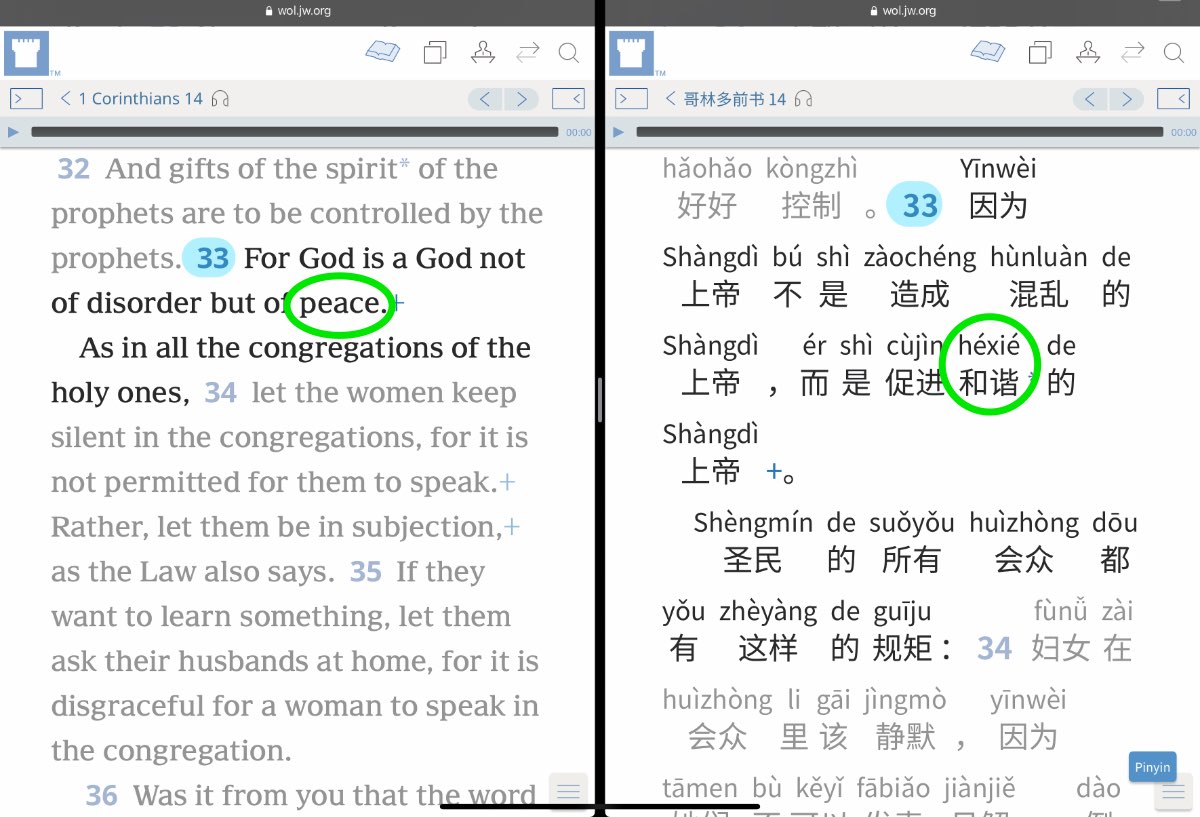héxié ({[is] harmonious} 和谐 和諧) ← Tap/click to show/hide the “flashcard”
Appendix A2 of the English New World Translation of the Holy Scriptures (Study Edition), entitled “Features of This Revision”, discusses vocabulary changes that have been made in the current revision, words that have been translated differently than before. As noted in various entries in the excellent resource Referenced Theo. Expressions (RTE), Appendix A2 of the current Mandarin version of the New World Translation Bible (nwtsty) correspondingly discusses words that have been translated differently in the current revision of the Mandarin NWT Bible, compared to how they had been translated before.
Since we base what we say in Jehovah’s service on his Word the Bible, the vocabulary used in it—and the way those vocabulary words are translated—should be reflected in how we speak in our ministry, at our meetings, etc. So, it is beneficial for us Mandarin field language-learners to be familiar with the latest thinking from the organization on how Bible terms should be translated into Mandarin.
Peace and Harmony in 1 Corinthians 14:33
Note that the current English version of the New World Translation Bible (Study Edition) uses the word “peace” at 1 Corinthians 14:33, and that the current Mandarin version of the New World Translation Bible (nwtsty) in that verse correspondingly uses this week’s MEotW, “héxié ({[is] harmonious} 和谐 和諧)”:

Why doesn’t the Mandarin translation use good old “píng’ān (píng’·ān {[is] flat, level, even → [[is] peaceful]} · {[is] safe, secure} (nwtsty-CHS Appx. A2 says this term mainly refers to things being smooth and stable, safe and secure, free of danger) 平安)” or “hépíng (peace | {[is] peaceful} (nwtsty-CHS Appx. A2 says this term mainly refers to the absence of war or conflict) 和平)” to translate “peace” in this verse? Appendix A2 of the current Mandarin version of the New World Translation Bible (nwtsty) explains that “píng’ān (píng’·ān {[is] flat, level, even → [[is] peaceful]} · {[is] safe, secure} (nwtsty-CHS Appx. A2 says this term mainly refers to things being smooth and stable, safe and secure, free of danger) 平安)” mainly refers to things being smooth and stable, safe and secure, free of danger, and that “hépíng (peace | {[is] peaceful} (nwtsty-CHS Appx. A2 says this term mainly refers to the absence of war or conflict) 和平)” mainly refers to the absence of war or conflict. These are are specific aspects of peace that don’t necessarily apply in every context.
We can see that those who translated the current Mandarin NWT Bible felt that the context of 1 Corinthians 14:33, which discusses who should speak when during meetings for spiritual encouragement, calls for “héxié ({[is] harmonious} 和谐 和諧)” to be used in this verse to translate the Greek word ei·reʹne, since the harmony that “héxié ({[is] harmonious} 和谐 和諧)” refers to contrasts well with the dissonance and disorder that would result if a meeting degenerated into a free-for-all of people speaking whenever and however they pleased.
“Harmony” and “Harmony”
You may recall that a past MEotW pointed out that the current Mandarin NWT Bible sometimes also uses “hémù ({[is] harmonious} 和睦)” in some places to also basically refer to “harmony”. Is there any difference between “hémù ({[is] harmonious} 和睦)” and “héxié ({[is] harmonious} 和谐 和諧)”?
Some comparing of a few different dictionaries seems to show that the main meanings of these words are similar, although there are different shades of meaning in the morphemes used—the “mù ({[is] peaceful; harmonious; amicable; friendly; amiable} 睦)” in “hémù ({[is] harmonious} 和睦)” has possible meanings involving being friendly and amicable, whereas the “xié ({[is] harmonious; in accord; | [is] humorous | agree; settle} 谐 諧)” in “héxié ({[is] harmonious} 和谐 和諧)” has possible meanings involving being in accord or in agreement.

